Notes on Arctic Cooling Accelero S1 and Revoltec Graphics Freezer Pro
for ATI X1900 XT in a Mac Pro
By Chrisso
Posted: Oct. 12th, 2007
Updated: Feb 11th, 2008 for later notes/comments
I thought I'd share my experiences with graphics card coolers as well.
(I've attached some images, some of them are rather blurry and not very detailed, but might give you an idea - sorry for the bad quality. One is a picture of the Revoltec cooler in my PC, just for illustrating why I wouldn't recommend it.)
I ordered the x1900XT upgrade kit for the Mac Pro (2x2Ghz) about a month ago and was lucky to get the card at a local Mac store for just
299 Euros - 100 euros less than the regular price. No idea why, it didn't appear to be used, just the package was a little bit worn out. However, the card went in, the performance was fantastic and the noise was awful, so I started reading through the user reports here and went off to the next PC store to buy an Accelero X2 cooler. But I was out of luck, all the stores nearby only had the coolers for nVidia cards (which seem to be much more popular at the moment). The guy at the counter suggested the (24.99 euros) Revoltec Graphics Freezer Pro instead, and I decided to give that one a try before going through the ordering (and probably waiting for weeks) process. Not the smartest idea as I figured out later. (Fit problems...)
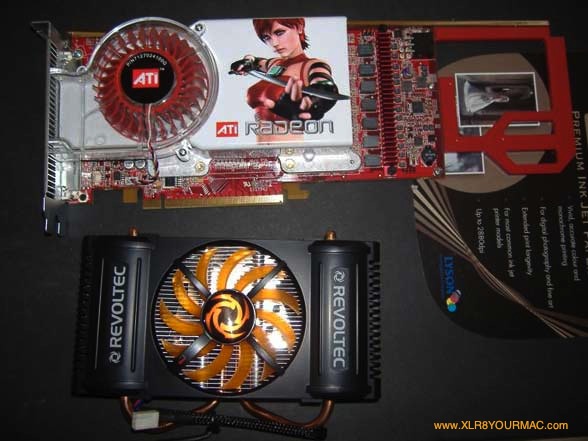
First off, the Revoltec installation wasn't really straight forward, there are some errors in the manual and it took me a while to find out that I have to place the screws differently than shown in the manual. I don't want to go into details here because in the end I found out that some screws on the backside of the card are too long and the card wouldn't fit into the standard slot (the one closest to the power supply) anymore. I could've moved the card up, but the Revoltec cooler is so huge it does not only block one more, but even two PCI slots, which was more than I was willing to give up.
So, slightly frustrated I picked up the phone and called another PC store, the guy immediately suggested that same Revoltec cooler of course, but after I told him it doesn't fit he said he has an Accelero S1, a passive cooler which can be upgraded with a "Turbo Module", two silent fans. Of couse that Turbo Module was not in stock.
Anyway, I looked at the product page and Arctic Cooling claims that even without the Turbo Module the cooling would be better than with the standard ATI cooler. Unbelievable, but after I've read one or two tests on the internet I thought I'd give it a try. I went to the store and bought it for 19.99 Euros (on the internet I even saw prices as low as 13 Euros). Back home I unpacked the things and thought that all this looked too light for an effective cooler. The Revoltec was a huge beast, heavy, polished and with that whole PC modder "I'm a man, I like big things" aura around it, while the Accelero is just a grill. A huge one, but a lightweight you can look through.
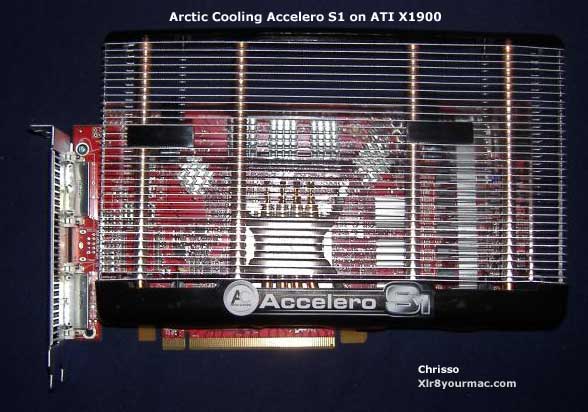
The installation was much easier than the Revoltec. First there's a long metal heatsink for the power regulators. This one is about twice the size of the stock ATI one and does look more reasuring. At this point, by the way, you have to remove the card support extension, that long metal thing Apple ships the cards with, and you won't be able to use it anymore, so it'd probably be a good idea to keep the card in the lowest slot.
Then you have 8 small heatsinks for the RAM, just stick them onto the chips. I've read some user reports about those RAM heatsinks falling off, but in my case they sticked fine. (maybe clean the chips well first) Maybe just a problem in PC cases where the card is installed upside down. (Or it might be due to the fact that I simply forgot to apply the thermal pads between the heatsinks and the RAM chips. For the simple reason that I didn't see those thermal pads in the package I assumed there were none required. At first I was shocked because of course I've read that part of the manual again after the installation was already finished. Well, but from some test reports on the net I learned that the RAM heatsinks are more for the good look and that those chips won't get too hot anyway, so we will see. I don't plan to overclock.) After that comes the main heatsink. Four screws and some plastic thingies to keep it in place. Those plastic things gave me a minute to think about, but I quickly found out what to do with them. There was some unavoidable wiggling involved after the preapplied thermal paste had touched the GPU, but not enough to make me nervous. And voila, after 10 minutes the card was ready to use. Not that it looked trustworthy, I expected to run into a catastrophe right after powering up my Mac.
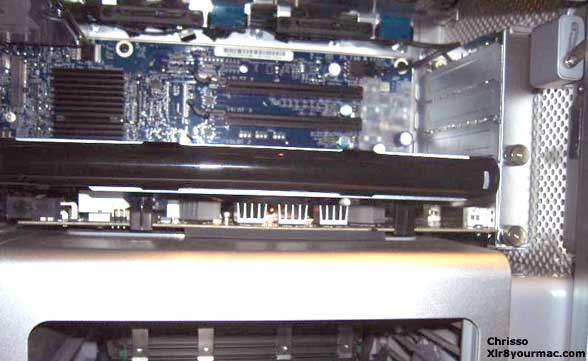
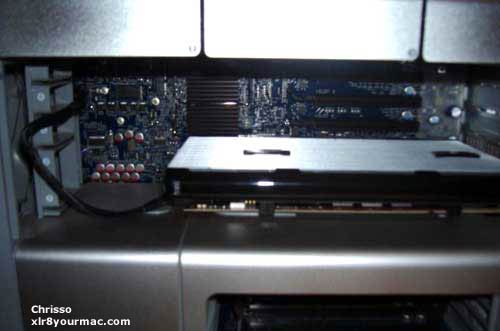
Strangely enough, the Mac Pro booted fine and I got a normal image on the screen, no artifacts at all. I opened the Mac again and touched the heatsink and it was cool. (At this point I noticed it is nearly impossible to remove the card again after it's in. That little plastic thing you have to pull to remove a PCIe or AGP card is totally blocked by the main heatsink, so cross fingers this card will last a while). I booted into Windows and opened up the ATI catalyst Control center. Overdrive reported 50 degrees C. Average.
But now to the really good point. I started Neverwinter Nights 2 in Windows and played a few minutes, then switched back to the Catalyst control center. 79 Degrees C. That's lower than what I've seen with the standard cooler - it had always been in the late 80's. I opened up the case and reached for the heatsink, preparing to burn my hand. Nothing, it was just warm, far from being hot. I played a while longer and the temperature went up to 84 degrees C. This was all at high graphics settings at 1600x1200, no AA though. And even without AA, NWN2 is very demanding and makes highend graphics cards sweat. The same night I played about 6 hours longer, forgetting about the new cooler and just enjoying the game with all it's bells and whistles, with no graphics anomalies at all and the Mac being absolutely quiet. At some point after long hours of playing I switched to the Catalyst Center again and it reported 88 Degrees C. Less than what I was used to from the standard cooler.
So far I still don't trust this cooler, because I'm a paranoid person and simply for the fact that there's no fan at all. But as it seems, it does everything to prove that passive cooling is possible and can even be very effective for this card. For now, I don't see a reason for adding those "Turbo Module" fans to the heatsink - Arctic Cooling advertises those as an upgrade for overclockers anyway.
As for the Revoltec (which was even more expensive), after my initial frustration was gone I decided to use it on an ATI X1950 Pro I bought for my cheap Athlon PC a while ago. Even for that I won't recommend it unless you have a really good case with additional support for PCI cards, and a mainboard with a lot of space between the PCI slots. The Revoltec cooler bends the card down and the only solution I can think of in my case is trying to keep the card in place with some tape or wire, not the most elegant solution. Also, it blocks every PCI slot I have in that system.
End view of Revoltec cooler (installed in PC)
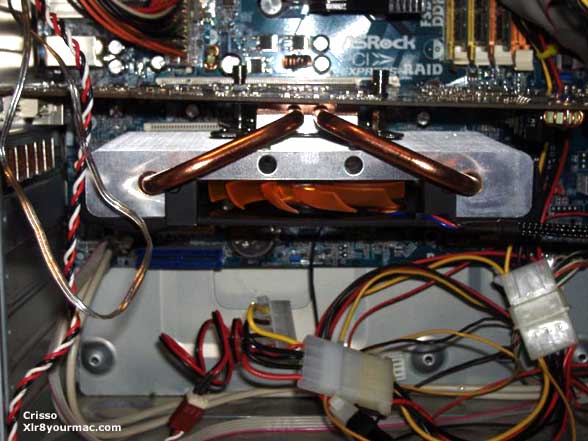
In the image above of the Revoltec cooler in the PC, you can clearly see those two screws that prevent the card from fitting into the lowest slot of the Mac Pro. No idea how those are called, but I can't think of an easy way to replace those with something shorter. Here's another (blurry) picture.

I'm not sure if this report is of any use for you, I admit I didn't run many tests yet and can only share my first impressions. But for those
who like it really quiet, I think it might be of interest.
Cheers, Chrisso
Update: (Feb 2008) (updated again)
I have a late follow up on my Accelero S1 review. I've used this card/cooler combo since my first mail without any problems, but recently some heat issues occured. Maybe by coincidence, maybe not, the card seems to run hotter than before since I updated the Catalyst driver in Boot Camp to the most recent version (v.8.1 now). As said in my review, the card has never been really cool, even with the standard cooler it easily reached the high 80's to low 90's degrees C while playing games. Since I updated drivers though, I already get some annoying artifacts when the card is in the low to mid 80's, this means, very early in a gaming session. However, this is only in Bootcamp with the new Catalyst drivers.
I have no clue about how high the temperature in OS X is exactly, (I don't have an X1900 but there's a freeware Temperature Monitor for OS X (free/less full featured version of Hardware Monitor)) but never ran into problems even after a 12 hour marathon through Call of Duty 2 just recently, so the easy solution for the problems in Boot Camp occured to me almost instantly. Even before I bought the ATI x1900 upgrade, I stumbled over this article on the internet: www.tenthousandpercent.com/?section=other&article=98 (includes link to (windows) ATI Tray Tools, mentioned last year also on the page here on Mac ATI OC'ing/Tweaking (it does more than just OC'ing) in Windows and by another X1900 owner using it to boost fan speeds in Windows XP last year. He noted his replacement X1900 card didn't seem to need it however.)
The problem is, apparently Windows is incapable of adjusting the Mac Pro fan speed, as are any 3rd party tools, so the Mac Pro fans always run at the same speed they had when you last used OS X. This means, a cold start into Windows, or a restart only after some everyday work in OS X results in minimum fan speed even when doing high performance tasks. Maybe this has changed in Leopard, I can only speak for the Boot Camp Beta/ 10.4.11 Tiger combination.
So what I do now is simple, although a little annoying: I start SMCFanControl right before rebooting into Windows. I manually turned the PCIe/HDD fan speed up to about 800rpm (even less would probably do, but when I run Windows, I usually do it to play for a few hours at least ;-) ), and just to be on the safe side, also gave the CPU and rear fan a slight increase. Rule of thumbs: Just turn up the speed of the PCIe fan until you hear it spin up a little, there's no need to have it at an annoying state, as the results in Boot Camp are fantastic. With just a slight adjustment, the card runs way cooler than ever before, and the Arctic Cooling heatsink really deserves it's name now. Even after playing for hours, the card runs 15 degrees cooler than before.
I think I'll get one of these turbo modules for the Heatsink now, it should provide enough cooling to make SMCFanControl obsolete, but for now, this method works fine.
Obviously, OS X does these things automaticly, so there's no need to have SMCFanControl active until you restart into Windows. I don't know if the Boot Camp drivers for Leopard are any better than the old ones from the Beta, but I realy think this Fan problem is something Apple should've taken care of.
(he later wrote)
In the meantime I came to the conclusion that the artifacts I saw came from buggy drivers, not from the heat the card generates, but I still use SMCFanControl just because it's feeling better to see the temperature in much lower regions. Lately, both nVidia and ATI don't seem to care much about OpenGL compatibility anymore. I've always had issues with nVidia cards and older OpenGL games like Neverwinter Nights 1 so I favored ATI cards, but it seems like AMD is catching up on the bug side.
In Windows, I'm using the ATI Tray Tools since day one, not for overclocking, but simply to have an eye on the temperature while playing games. There's also a screenshot function I'm making a lot of use of (no print screen key) and some minor tweaking for problematic games.
In OS X, I still have Temperature Monitor lying around somewhere, but I don't use it often - Mac OS X works just fine and I don't care much for the details. (I just wanted to mention it after you said earlier (above) "I have no clue about how high the temperature in OS X is exactly" - wasn't sure you had used it from that comment.) Tweaking and optimizing is a Windows domain, it's not that I enjoy it, but it seems to be necessary
Regards, Chrisso
|